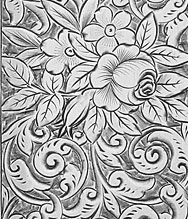Nickel Silver - plain with no decoration
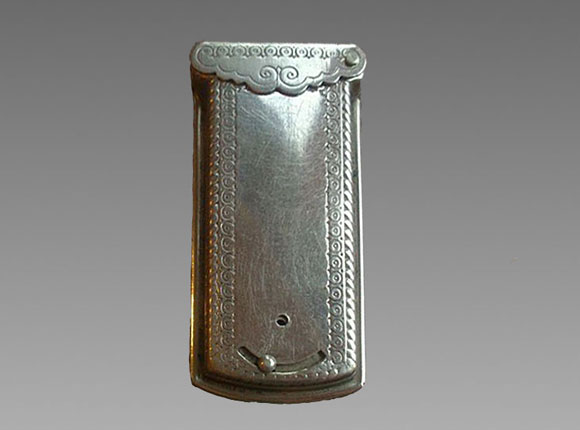
Needle Case
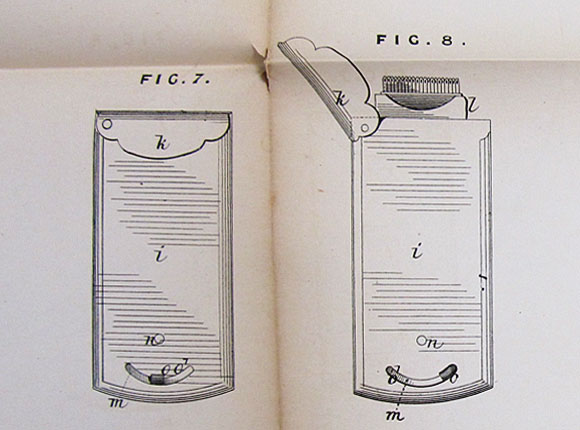
UK Patent 1868-3517 drawing
Note: In May 2022, after discovering The Silver Needle Case with the Cook, Son & Co name and a center logo with the initials C S, it was decided that this nickel silver
Quadruple with the C. S & Co name on the end cap was most likely produced for the Cook, Son and & Co. Apparently because the end cap was so small, the company decided to
use its initials instead of their full name. Additional research was undertaken to determine if there was another company in the London area during the Victorian period
with these initials. Only two companies were found: C. S. Cox & Co. in 1904 and C. S. Hyman & Co in 1908. It is highly unlikely that these companies had anything to
do with this needle case because both companies were not listed until after 1900 and all other evidence suggests Avery needle cases were only produced from 1867-1890, except
for several which were made in 1897 for Queen Victoria’s diamond jubilee. Also, if these companies wanted to shorten their names it is more reasonable to assume they would
remove the initials and simply be listed as Cox & Co or Hyman & Co. This information was shared with four other collectors to get their opinion on whether they agreed that
C. S. & Co was most likely the abbreviation of Cook, Son & Co. This included: Lynda Herrod an Avery needle case collector from Australia, Colin Jackson an antique jewelry
collector from the UK and Brooks Popowitch and Kris Beaulieu thimble collectors from the TONI collector’s club in the Chicago area. All four agreed with my assumption.
Therefore, unless addition information is uncovered in the future, this nickel silver Quadruple will be listed as one made for Cook, Son & Co.
.
Design Details
Needle Case Type: |
Quadruple |
Patent/Registered to: |
William Avery, Redditch Needle Manufacturer and Albert Fenton of the same place, Machinist |
Patent/Design Representation #: |
Mechanical Patent: #3517 |
Patent/Design Registration Date: |
November 19, 1868 |
Location of Patent/Design Registration: |
British Library - Business and Intellectual Property Centre – London |
Reference #: |
1868-3517, Figures 7-10 |
Dimensions: |
3.3 x 7 |
Material: |
Nickel-silver |
Name Variations: |
a) W. Avery & Son - Redditch
b) C. S. & Co - London (aka Cook, Son & Co, London)
c) Evans & Owen - Bath
d) Stacy - London |
Other Variations: |
See other Quadruples |
US Patent |
US 1870-98904 |
Additional Photographs
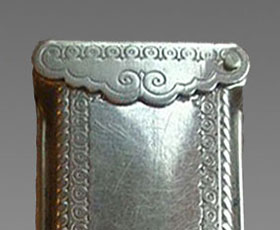
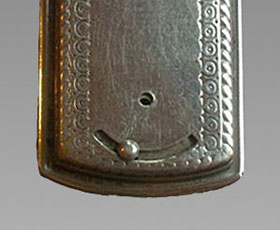
Detail views
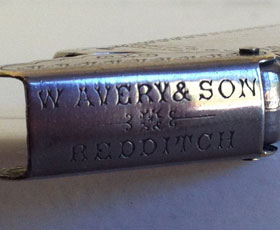
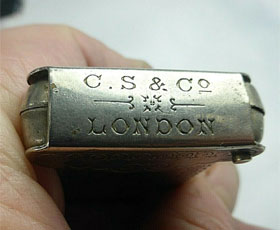
End cap signed by Avery and by C. S. & Co (aka Cook, Son & Co.)
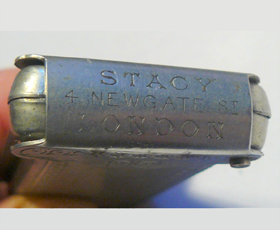
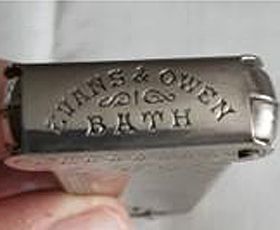
End cap signed by Stacy (photo from eBay) and end cap signed by Evans & Owen (photo courtesy of Chris Brett)
It seems most likely that this nickel-silver needle case was intentionally manufactured without decoration, presumably so it could be custom
engraved for the individual who purchased it. However, to date all known examples are plain, none have have been found with engraving.
Why this is will remain a mystery.
Nickel-Silver
Nickel-silver is an alloy of copper, zinc and nickel. The most common formula is 60% copper, 20% nickel and 20% zinc. Nickel-silver
was originally developed in China and the alloy was exported to Europe during the 17th century. German imitations began to appear around 1750
and in 1823 a competition was held in Germany to perfect the alloy which had the appearance of silver but was much less costly. The end result
was a product known as “German silver” or nickel-silver. Nine years later in 1832 a form of nickel-silver was also developed in Birmingham,
England where it became a popular metal used in manufacturing decorative items during the Victorian Period. When examining an item that
appears to be made of silver but lacks the appropriate hallmarks, it is often difficult to tell whether it is made of nickel-silver or plated with
nickel-silver. The photograph below is a detail of another needle case that appears to be made of nickel-silver. Click on the photo to
visit the webpage for this needle case.
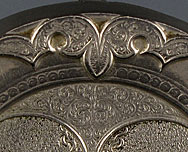
Electroplating
Electroplating involves placing a thin layer of gold, silver or nickel onto an object made of another metal, such as brass, bronze or
copper. Avery style needle cases were most likely plated with nickel to give them the appearance of silver. Although an older plating
process had been around for years electroplating, which was invented in the early 1800s, proved less expensive because it required less metal and
could be done in a more efficient manner. A bath, consisting of water, sulfate of nickel and ammonium, was prepared in a container made of a
non-conductive material such as earthenware to which a plate of nickel was added. Prior to immersion, workmen attached the items to be plated
to a metal rod and then submerged them in the solution. They connected the nickel plate to the positive pole of a battery, and the metal rod,
on which the items were hung, to the negative pole. The electrical current passing through the solution caused the nickel from the sulfate
bath to condense on the object, while the nickel from the plate dissolved and became nickel sulfate. The length of time the item remained in
the bath determined the thickness of the plate. Because over 130 years have passed since Avery needle cases were made, ones that were
electroplated usually show evidence of wear and one can often see the brass showing through as in the detailed example below. Click on the
photo to visit the webpage for this needle case.
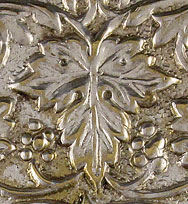
Engraving
Engraving is the process of cutting or carving a design onto a hard, flat surface such as wood, stone or metal using a small chisel or
tool. In fine art the term engraving is used to describe the printed image created from the incised wood or metal plate that contains
the design. With jewelery and other ornamental items professional hand engravers are able to add detailed scenes and elaborate scrollwork or
geometric patterns like the ones seen on the needle case on this page. Often an individual’s initials are inserted to give the item a
personalized touch. Items with customized hand engraving are usually more expensive than ones decorate by machine processes. Click on
the photo below to visit the webpage of a needle case with engraving.
